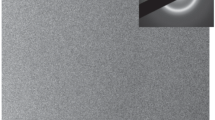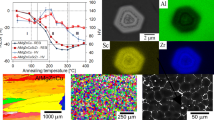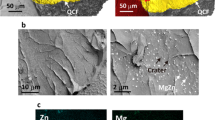Abstract
This paper describes an experimental investigation of the change in etch-pit density (ρ) in aluminium and lithium fluoride crystals after anneals of varying duration (up to 10 h) near the melting point, either without pressure or under hydrostatic pressures of up to 10 kbar. It is found that, when the temperature is high enough (near the melting point), the action of pressure promotes lowering of the etch-pit density after the anneal. For instance, in the case of aluminium, the reduction in ρ after a 10 h anneal at 630° C under a pressure of 10 kbar is 100 times greater than under the same conditions without pressure. But for 550° C annealing temperature, the influence of pressure on change in ρ is already insignificant. In the case of lithium fluoride, annealing at 810° C (6 h) under a pressure of 8 kbar diminishes ρ by a factor of 30. At 750° C, the application of 8 kbar pressure reduces ρ only by a factor of 5 compared with atmospheric pressure.
The effect of pressure, and its temperature dependence, is qualitatively explained in the following way. Under pressure near the melting point, the microcracks, which always exist in solids, are healed (i.e. sintered). The inner surfaces of these microcracks serve as sources and sinks for Schottky vacancies. Therefore, during the establishment of an equilibrium vacancy concentration, when the microcracks are healed, dislocations begin to act as vacancy sources (or sinks) and this results in the acceleration of their climb and consequential annihilation (i.e. a reduction in dislocation density).
The comparison of literature data on dislocation density (N) in pure aluminium samples cooled (after anneal) at different rates, and of etch-pit density for similarly treated aluminium samples shows that, under our experimental conditions, ρ and N coincide in order of magnitude.
Similar content being viewed by others
References
A. H. Cottrell, “Dislocations and Plastic Flow in Crystals” (Clarendon Press, Oxford, 1952).
B. Nost and G. Sorensen, Phil. Mag. 13 (1966) 1075.
E. Nes and B. Nost, ibid p. 855; B. Nost, ibid 11 (1965) 183.
A. Steele and A. Seeger, Z. Physik 146 (1956) 217.
A. Seeger, Phil. Mag. 3 (1958) 470.
W. M. Lomer, ibid 2 (1957) 1053.
A. Smakula, J. Kalnajs, and V. Sils, Phys. Rev. 99 (1955) 1747.
M. J. Hordon and B. L. Averbach, Acta Met. 9 (1961) 247.
M. F. Straumanis, P. Borgeaud, and W. J. James, J. Appl. Phys. 32 (1961) 1382.
K. F. Neymayer, “Kholodnaya i goryachaya shtampovka metallov” (ONTI, Moscow, 1935).
L. A. Shoffmann, “Theoria i rastchoty prozessov kholodnoj shtampovki” (Mashinostroyenie, Moscow, 1964).
B. Ya. Pines and A. F. Syrenko. Izvest. Vuz'ov, Chornaya Metal. 2 (1960) 81.
J. E. Hilliard, J. M. Lommel, I. B. Hudson, D. F. Stein, and J. D. Livingstone, Acta Met. 9 (1961) 787.
G. Wyon and P. Lacombe, “Rep. Conf. Defects in Solids” (Physical Society, London, 1955), p. 187.
D. Barber, Phil. Mag. 7 (1962) 1925.
Author information
Authors and Affiliations
Rights and permissions
About this article
Cite this article
Pines, B.Y., Syrenko, A.F. Change of dislocation density in aluminium and lithium fluoride after annealing near the melting point under hydrostatic pressure. J Mater Sci 3, 80–88 (1968). https://doi.org/10.1007/BF00550893
Received:
Revised:
Issue Date:
DOI: https://doi.org/10.1007/BF00550893




